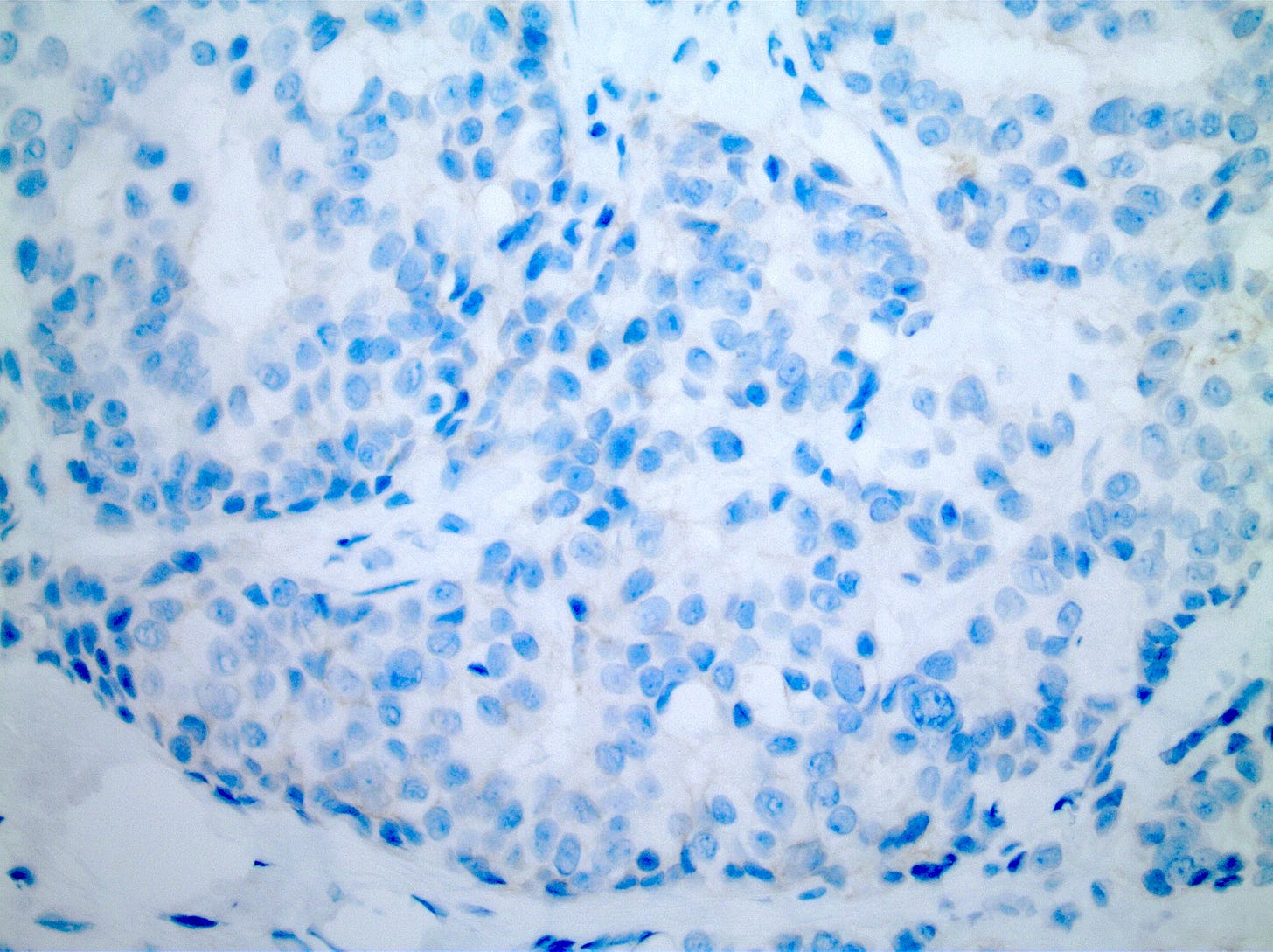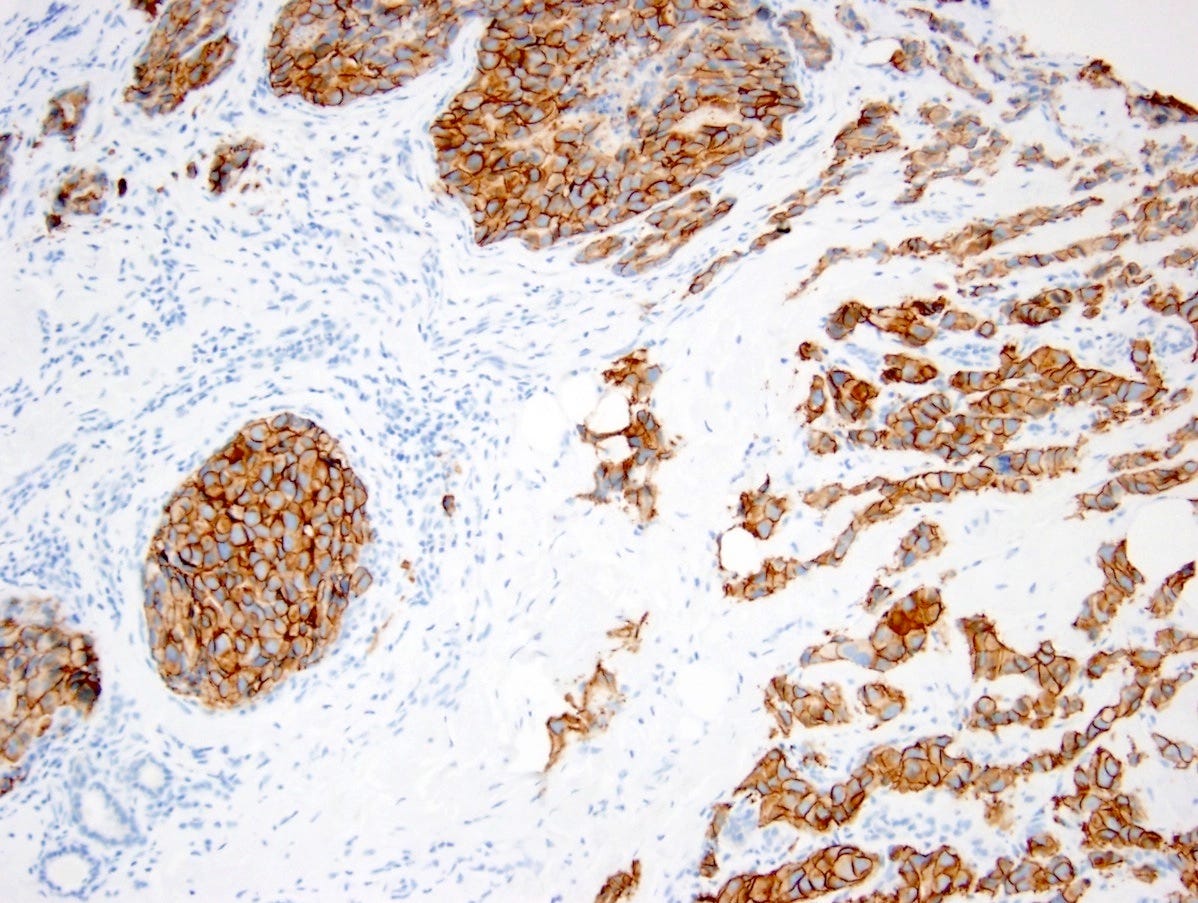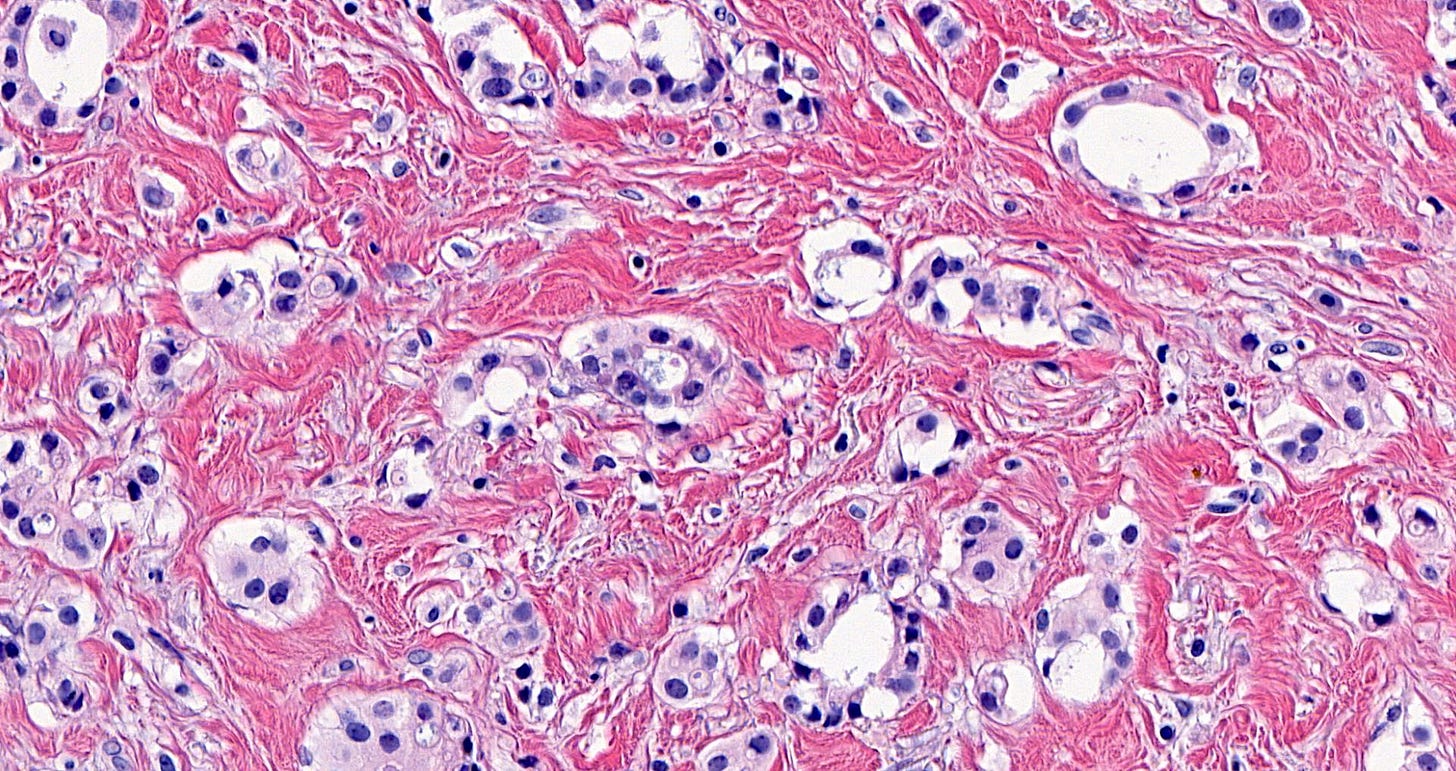Cancer precursor project - breast cancer, part 6k
27 April 2025, revised 14 May 2025
This weekly medical blog focuses on science, not politics. For political commentary, I maintain a separate daily blog. Feel free to skip any essays or sections that don't interest you - no offense will be taken.
This essay is part of my cancer precursor project that discusses how different types of cancer arise. Part 6 discusses breast cancer. Click here for links to discussions for all 45 breast cancer types (some are pending).
This essay discusses triple negative breast cancer, defined as an invasive breast cancer that lacks expression of estrogen receptor (ER), progesterone receptor (PR) and HER2 by immunohistochemistry. It represents 16% of invasive breast cancers.
Executive Summary:
Triple negative breast cancer (TNBC) is defined as invasive breast cancer that lacks expression of the estrogen receptor (ER), progesterone receptor (PR) and HER2, as determined by immunohistochemistry. It accounts for approximately 16% of invasive breast cancers.
These tumors should primarily be classified by their histologic type, as histology more accurately predicts behavior than the triple negative label alone. The absence of ER, PR and HER2 expression does not confer a distinct gross or microscopic appearance, nor does it define clinical behavior.
Most triple negative breast cancers are poorly differentiated or high grade (grade 3) invasive ductal carcinomas of no special type.
However, 22 of the 44 recognized breast cancer types are triple negative in more than 50% of cases, although many of these types are rare.
Breast cancers can be triple negative for several reasons:
They arise from cells that are naturally triple negative
They undergo metaplastic changes unrelated to malignancy that result in a triple negative phenotype
During malignancy, they adopt a phenotype typically associated with triple negativity (such as salivary gland cells)
They maintain the histologic appearance of breast epithelial cells but lose ER and PR expression during the malignant transformation
Although TNBCs are often aggressive, some of the 22 associated types display less aggressive behavior.
Finally, while HER2 overexpression typically signals aggressive disease, triple negative cancers are HER2 negative, suggesting they follow a different malignant pathway.
Microscopic images of ER, PR and HER2
Estrogen receptor staining



Progesterone receptor staining


HER2 staining


Triple negative cancers should primarily be classified by their histologic type, as histology more accurately predicts behavior than the triple negative label alone. The absence of ER, PR and HER2 expression does not confer any distinct gross or microscopic appearance, nor does it define clinical behavior.
Most triple negative breast cancers are poorly differentiated or high grade (grade 3) invasive ductal carcinomas of no special type. However, there are actually 44 breast cancer types other than triple negative breast cancer listed in our spreadsheet of all human cancers, although some are very rare. Based on our review of the literature:
22 are triple negative in > 50% of cases
4 are triple negative in 25 - 50% of cases
9 are triple negative in 5 - 24% of cases
9 are triple negative in < 5% of cases
Breast cancer types that are triple negative in > 50% of cases
acinic cell carcinoma, almost always triple negative
adenoid cystic carcinoma, almost always triple negative
adenomyoepithelioma with carcinoma, most cases, although data is limited
angiosarcoma including postradiation, limited data but likely triple negative because not derived from or differentiated towards breast epithelium
BRCA associated carcinoma, 75% of tumors in BRCA1 carriers are triple negative, compared to up to 23% in BRCA2 carriers
breast implant associated anaplastic large cell lymphoma, almost all cases because a lymphoma, not derived from or differentiated towards breast epithelium
epithelioid angiosarcoma, appears to be triple negative because it is a sarcoma not derived from breast epithelium but data are limited; it may occasionally be differentiated towards breast epithelium and be HER2+
malignant granular cell tumor, appears to be triple negative although data is limited; derived from neuroectodermal tissue not from breast epithelium
malignant phyllodes tumor, a breast stromal tumor that behaves like a sarcoma; typically HER2 negative, stromal tumors are presumed ER and PR negative with limited data available
metaplastic carcinoma (NOS), this diagnosis is for cases that are not squamous cell carcinoma, low grade adenosquamous carcinoma or low grade fibromatosis-like carcinoma
polymorphous adenocarcinoma, only 3 cases reported in the breast
secretory carcinoma, either triple negative or weakly ER positive
Breast cancer types that are triple negative in 25 - 50% of cases:
neuroendocrine carcinoma-large cell, < 50% (only 4 cases studied), 1 pure case was triple negative but HER2 low by FISH, 1 mixed with invasive ductal carcinoma was negative in the large cell component
Breast cancer types that are triple negative in 5 - 24% of cases:
encapsulated papillary carcinoma with invasion, 16.7% are ER- PR- or HER2+ (Table 2, column 3)
HER2 low breast cancer, cases with HER2 score of 1+ are interpreted as negative; 15 - 20% of HER2 low cases
infiltrating ductal carcinoma of no special type, 10 - 15% of cases
mixed NST, 10% were ER-, 16% were PR-, 82% were HER2- (Table 1)
oncocytic carcinoma, study indicates “oncocytic carcinomas show HER2 overexpression”
Breast cancer types that are triple negative in < 5% of cases:
neuroendocrine tumor, grade 2 (they are considered distinct tumors), 94% (68 of 72) of NETs were ER positive and 71% (51 of 72) were PR positive and most are HER2 negative
tubular carcinoma, almost always ER+ and PR+
tubulolobular carcinoma, almost always ER+ and PR+
Other breast cancers not considered one of the above breast cancer types may also be triple negative:
Basal-like breast cancers comprise about 80% of triple negative cancers but are actually defined by molecular (gene expression) profiling. Basal cell breast cancer is not considered a distinct subtype in the WHO classification of breast malignancies.
Infiltrative ductal carcinoma of no special type, grade 3, is a variant of infiltrative ductal carcinoma discussed above.
How breast cancers become triple negative
Breast epithelial cells are typically estrogen receptor (ER) positive, progesterone receptor (PR) positive, and HER2 negative. However, some breast cancer types are composed of cells that are inherently triple negative, meaning malignant transformation does not alter their ER, PR, or HER2 expression. This group includes six tumors arising from mesenchymal, lymphoid, neuroectodermal and myoepithelial cells - cell types that are naturally present in breast tissue. It is important to note that the term "triple negative" often refers specifically to carcinomas, which does not apply to the first four tumors listed below.
angiosarcoma including postradiation - mesenchymal
breast implant associated anaplastic large cell lymphoma - lymphoid
epithelioid angiosarcoma - mesenchymal
malignant granular cell tumor - neuroectodermal
adenomyoepithelioma with carcinoma - myoepithelial
myoepithelial carcinoma - myoepithelial
In addition, some triple negative breast cancers arise from benign metaplastic changes that are already triple negative.
apocrine carcinoma: may arise from apocrine metaplasia, a common condition which is triple negative (ER / PR negative, HER2 negative in 2/3 cases)
metaplastic - low grade adenosquamous carcinoma: may arise from adenosquamous proliferations, which are usually triple negative
In some cases, the malignant process causes tumor cells to develop a phenotype (i.e. microscopic appearance) that resembles cells typically found in triple negative tumors. This is not considered a metaplastic change because the cells are already malignant.
For example, these six salivary gland malignancies in the breast typically do not have any benign salivary gland precursors in the breast and the malignancies are typically not associated with benign salivary gland tumors - the changes in differentiation and malignant transformation are simultaneous:
acinic cell carcinoma: note that microglandular adenosis, which is benign and triple negative, but does not resemble salivary glands, may be a precursor
secretory carcinoma, either triple negative or weakly ER positive: the ETV6-NTRK3 fusion gene is believed to play a crucial role in the development and growth of these tumors
In the following cases, the malignant process appears to alter protein expression in breast epithelial cells, resulting in a triple negative profile while the cells still retain characteristics of breast epithelial cells. Often, these tumors have no identifiable precursor in the breast.
BRCA associated carcinoma: About 75% of tumors in BRCA1 carriers are triple negative compared to up to 23% in BRCA2 carriers. No premalignant precursor is known.
Malignant phyllodes tumor: This is a breast stromal tumor that behaves like a sarcoma although it has an epithelial component. It arises either de novo or from benign phyllodes tumors. The stromal component is typically triple negative although the epithelial component, which may be benign, is not.
Medullary carcinoma: Some cases are associated with BRCA1 mutations. Histologically, these tumors show pushing borders, syncytial growth, high grade nuclei and a prominent lymphoid infiltrate. Medullary carcinoma represents one end of the spectrum of tumor infiltrating lymphocyte (TIL) rich invasive breast carcinomas of no special type rather than a distinct morphological subtype. No precursor has been identified.
Metaplastic - low grade fibromatosis-like carcinoma: These triple negative tumors may arise from papillomas or complex sclerosing lesions, which are often positive for estrogen receptors and thus are not triple negative themselves.
Metaplastic - squamous cell carcinoma: Thought to arise from extensive squamous metaplasia in benign conditions such as cysts, chronic inflammatory conditions, abscesses or intraductal papillomas, followed by malignant transformation. Although the squamous component of the carcinoma is triple negative, there is little data on whether the precursor squamous metaplasia is also triple negative.
Metaplastic carcinoma (other types): Other metaplastic carcinomas may also arise from metaplastic changes followed by malignant transformation. However, most publications do not separate these cases, making it difficult to determine if the metaplasia was triple negative before malignancy.
Mucinous cystadenocarcinoma: This rare tumor may arise from mucinous metaplasia followed by malignant transformation. There is little data on the ER status of benign mucinous metaplasia.
Neuroendocrine-small cell carcinoma: This tumor is often triple negative (5 of 7 cases, 71%). It may arise from neoplastic transformation of native neuroendocrine cells in the breast or from invasive or in situ breast carcinomas that develop neuroendocrine features.
Note that HER2 overexpression in the breast is typically a marker of aggressive breast tumors, regardless of their differentiation. However, triple negative carcinomas are also typically considered aggressive although HER2 is negative. This is because breast malignancies undergo different transformation pathways in which HER2 may be positive or negative.
The next essay, part 6l, will discuss 4 other triple negative breast cancers without known precursors.
If you like these essays, please subscribe or share them with others.
Click here for the Index to Nat’s blog on Cancer and Medicine.
Follow me on LinkedIn, Threads and Instagram (@npernickmich) or Bluesky (@natpernick.bsky.social).
Follow our Curing Cancer Network through our Curing Cancer Newsletter, on LinkedIn or the CCN section of our PathologyOutlines.com blog. Each week we post interesting cancer related images of malignancies with diagnoses plus articles of interest. Please also read our CCN essays.
Latest cancer related documents:
American Code Against Cancer (how you can prevent cancer)
Email: Nat@PathologyOutlines.com (please note I cannot provide medical advice)
Follow my Substack Notes — subscribers are automatically notified.







